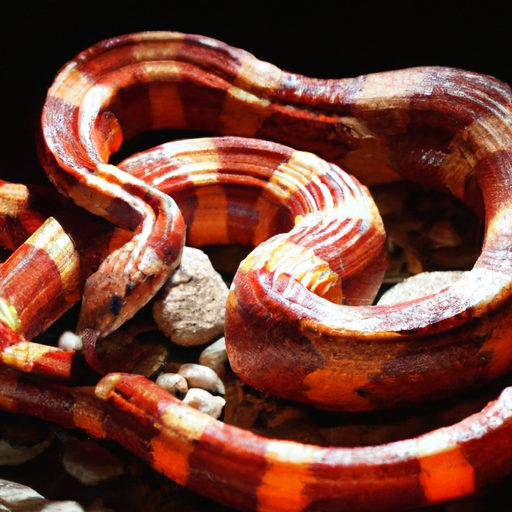So you’ve just brought home a new pet corn snake and now you’re wondering if it needs a heat lamp. Well, here’s the lowdown: corn snakes are ectothermic, meaning they rely on external sources of heat to regulate their body temperature. While providing a heat lamp is a common practice for reptile owners, it might not be necessary for corn snakes. In this article, we’ll explore the factors to consider when deciding whether or not to use a heat lamp for your corn snake, and offer some alternatives that can provide the warmth your slithery friend needs to thrive.

Benefits of heat lamps for corn snakes
When it comes to keeping corn snakes as pets, providing the proper temperature is essential for their health and well-being. One popular heating option is the use of heat lamps. Heat lamps offer several benefits for corn snakes, including replicating their natural habitat, ensuring proper temperature regulation, and providing a convenient and efficient heating solution.
Understanding the natural habitat of corn snakes
Before delving into the benefits of heat lamps, it is important to understand the natural habitat of corn snakes. Corn snakes are native to the southeastern United States, where they can be found in a variety of environments, from grasslands to forests. This means that they are accustomed to a specific temperature range and require certain conditions to thrive.
Native environment
In their native environment, corn snakes experience temperature fluctuations depending on the time of day and the season. They have the ability to move freely between warm and cool areas to regulate their body temperatures. This ability is crucial for their overall health and allows them to digest food properly, shed their skin successfully, and engage in normal behaviors.
Temperature requirements
To ensure the well-being of your corn snake in captivity, it is important to replicate their natural temperature requirements as closely as possible. Corn snakes generally require a basking area with temperatures ranging from 85-90°F (29-32°C) and a cooler area in the range of 75-80°F (24-27°C). Maintaining these temperature ranges is crucial for their overall health and happiness.
Importance of proper temperature regulation
Proper temperature regulation is vital for corn snakes to maintain their metabolic rate, digestion, and overall health. Without the correct temperature gradient, corn snakes may suffer from issues such as poor appetite, digestion problems, respiratory infections, and even stress-related disorders. In extreme cases, improper temperature regulation can lead to serious health complications and even death.
Different heating options for corn snakes
For providing the necessary heat gradient in their enclosure, there are several heating options available for corn snakes. Let’s take a look at some of the commonly used heating options:
Heat mats
Heat mats, also known as under-tank heaters, are a popular option for corn snake owners. These mats are placed under one side of the terrarium to create a warm spot for the snake to bask. Heat mats provide a consistent and gentle heat source, promoting healthy digestion and thermoregulation for corn snakes. However, it is important to use a thermostat with heat mats to prevent overheating and ensure temperature control.
Heat tape
Similar to heat mats, heat tape is another option that can be used to create a warm area in the terrarium. Heat tape is a thin, flexible strip that can be placed under the terrarium or inside the enclosure. It provides consistent heat and can cover a larger area than heat mats. However, like heat mats, the use of a thermostat is important to regulate the temperature effectively.
Ceramic heat emitters
Ceramic heat emitters, also known as CHEs, are heat sources that emit infrared radiation for heating the terrarium. These heat emitters do not produce visible light, making them ideal for providing a heat source during the night without disturbing the snake’s sleep patterns. Ceramic heat emitters can be used alongside other heating options to ensure a proper temperature gradient.
Infrared heat lamps
Infrared heat lamps, commonly referred to as heat bulbs or basking bulbs, are another heating option for corn snakes. These bulbs produce both heat and light, simulating the sun’s rays and promoting natural behavior in the snake. Infrared heat lamps can be used to create a basking spot in the terrarium, allowing the snake to regulate its body temperature effectively. However, it is important to choose a bulb with the appropriate wattage and to provide a safe distance between the snake and the lamp to avoid overheating or burns.
Advantages and disadvantages of using heat lamps
While heat lamps offer several benefits for corn snakes, it is important to consider both the advantages and disadvantages before incorporating them into your setup.
Advantages
One of the primary advantages of using heat lamps is their ability to provide both heat and light. This helps to simulate the natural day and night cycle for your corn snake, promoting healthy behaviors and regulating their internal clock. Additionally, heat lamps offer a focused heat source, allowing the snake to bask and regulate its body temperature effectively. They are also relatively easy to set up and can be used in combination with other heating methods to ensure a proper temperature gradient.
Disadvantages
One disadvantage of using heat lamps is the potential risk of overheating if not used properly. It is crucial to choose the right wattage bulb and to monitor the temperature regularly to prevent overheating and ensure a safe environment for the snake. Additionally, heat lamps can produce visible light, which may disrupt the snake’s sleep patterns if used during the night. It is important to consider the specific needs of your corn snake and adjust the lighting accordingly.
Factors to consider before using a heat lamp
Before incorporating a heat lamp into your corn snake’s enclosure, there are several factors to consider to ensure their safety and well-being.
Terrarium size
The size of your corn snake’s terrarium should be taken into account when deciding on the heating method. Heat lamps require adequate space to provide a proper temperature gradient and prevent overheating. It is important to choose a lamp that adequately covers the desired basking area without producing excessive heat in the rest of the enclosure.
Heating requirements
Each corn snake may have slightly different heating requirements, depending on factors such as age, size, and health. It is crucial to research and understand the specific needs of your snake to determine the appropriate wattage and temperature range for the heat lamp. Consulting with a reptile veterinarian or experienced snake keeper can help ensure that you are providing the correct heat source for your corn snake.
Safety precautions
Safety should be a top priority when using any heating method for your corn snake. It is important to use a thermostat or temperature controller to prevent overheating and maintain a consistent temperature. Additionally, ensuring that the heat lamp is securely mounted and cannot fall into the enclosure is essential to avoid potential harm to your snake. Regularly inspecting the heat lamp and its components for any signs of wear or damage is also crucial to prevent accidents or malfunctions.
Proper setup of a heat lamp for corn snakes
To ensure the effective and safe use of a heat lamp for your corn snake, the following steps should be followed:
Choosing the right heat lamp
Selecting the appropriate heat lamp is vital for creating the necessary temperature gradient in the terrarium. Consider factors such as wattage, type of bulb (infrared or basking), and the manufacturer’s recommendations. It is always best to choose a lamp specifically designed for reptiles and to avoid using household bulbs that may emit harmful radiation.
Placement within the terrarium
Proper placement of the heat lamp is essential for creating a suitable basking spot and temperature gradient. The lamp should be positioned outside the enclosure, with a safe distance between the snake and the bulb to prevent burns or overheating. It is also important to ensure that the light emitted by the bulb does not cause excessive stress or disrupt the snake’s natural behavior.
Temperature monitoring
Regularly monitoring the temperature within the terrarium is crucial to ensure that it remains within the appropriate range. Using a reliable thermometer, measure the temperature both at the basking spot and the cooler end of the enclosure. Adjust the height and wattage of the heat lamp if necessary to maintain the desired temperatures. Keep a record of the temperature readings to track any fluctuations and adjust the heating setup accordingly.
Signs of improper temperature regulation
It is important to be aware of the signs that your corn snake may be experiencing improper temperature regulation. Some key indicators include:
- Lack of appetite or refusal to eat
- Digestive issues such as regurgitation or incomplete shedding
- Lethargy or reduced activity levels
- Frequent or prolonged visits to the cooler side of the enclosure
- Signs of stress, such as excessive hiding or aggression
If you notice any of these signs, it is important to reassess your heat lamp setup and consult with a reptile veterinarian if necessary.
Common misconceptions about heat lamps for corn snakes
There are several common misconceptions surrounding the use of heat lamps for corn snakes. One of the most prevalent misconceptions is that corn snakes require heat lamps to survive. While heat lamps can provide a suitable heat source, they are not the only method for achieving proper temperature regulation. As mentioned earlier, heat mats, heat tape, and ceramic heat emitters are also effective options. It is important to consider the specific needs of your corn snake and choose the heating method that best suits their requirements.
Conclusion
In conclusion, heat lamps can be a beneficial heating option for corn snakes when used correctly and in combination with other temperature regulation methods. They offer the ability to create a suitable basking spot and temperature gradient, replicating the snake’s natural habitat and ensuring their overall health and well-being. However, it is important to consider factors such as terrarium size, heating requirements, and safety precautions to provide a safe and comfortable environment for your corn snake. Regular monitoring and adjustments are crucial to maintaining the desired temperature range and identifying any issues with temperature regulation promptly. By understanding the benefits and considerations of heat lamps, you can create an optimal environment for your corn snake and help them thrive in captivity.




